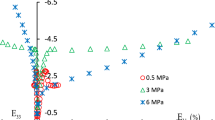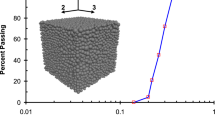Abstract
A three dimensional (3D) mesoscale model of concrete is presented and employed for computational homogenization in the context of mass diffusion. The mesoscale constituents of cement paste, aggregates and interfacial transition zone (ITZ) are contained within a statistical volume element (SVE) on which homogenization is carried out. The model implementation accounts for ITZ anisotropy thereby the diffusivity tensor depends on the normal of the aggregate surface. The homogenized response is compared between 3D and 2D SVEs to study the influence of the third spatial dimension, and for varying mesoscale compositions to study the influence of aggregate content on concrete diffusivity. The computational results show that the effective diffusivity of 3D SVEs is about 40 % greater than 2D SVEs when ITZ is excluded for the SVE, and 17 % when ITZ is included. The results are in agreement with the upper Hashin–Shtrikman bound when ITZ is excluded, and close to the Taylor assumption when ITZ is included.












Similar content being viewed by others
Notes
i.p.= intersection point.
Superscripts \(M\) denotes macroscale, whereas \(s\) denotes subscale.
References
Asahina D, Bolander JE (2011) Voronoi-based discretizations for fracture analysis of particulate material. Powder Technol 213(1–3):92–99. doi:10.1016/j.powtec.2011.07.010
Bentz DP, Garboczi EJ, Snyder KA (1999) A hard core/soft shell microstructural model for studying percolation and transport in three-dimensional composite media. U.S. Department of Commerce, Technology Administration, National Institute of Standards and Technology
Bentz D, Quenard D, Kunzel H, Baruchel J, Peyrin F, Martys N, Garboczi E (2000) Microstructure and transport properties of porous building materials. II: Three-dimensional X-ray tomographic studies. Mater Struct 33(3):147–153. doi:10.1007/BF02479408
Caballero A, Lopez C, Carol I (2006) 3D meso-structural analysis of concrete specimens under uniaxial tension. Comput Methods Appl Mech Eng 195(52):7182–7195. doi:10.1016/j.cma.2005.05.052
Carol I, Idiart A, López C, Caballero A (2007) Multiaxial behavior of concrete: a mesomechanical approach. Eur J Environ Civ Eng 11(7–8):907–926. doi:10.3166/regc.11.907-926
de Berg M, Otfried Cheong, van Kreveld M, Mark Overmars (2008) Computational geometry: algorithms and applications. Springer, TELOS, Santa Clara, 3rd edn. ISBN 3540779736, 9783540779735
Garboczi E (1998) Multiscale analytical/numerical theory of the diffusivity of concrete. Adv Cem Based Mater 8(2):77–88. doi:10.1016/S1065-7355(98)00010-8
Geers MGD, Kouznetsova VG (2010) Multi-scale computational homogenization: trends and challenges. J Comput Appl Math 234(7):2175–2182. doi:10.1016/j.cam.2009.08.077
Gross D, Seeling T ((2001)) Fracture mechanics: with an introduction to micromechanics. Springer, Berlin
Hain M, Wriggers P (2007) Numerical homogenization of hardened cement paste. Comput Mech 42(2):197–212. doi:10.1007/s00466-007-0211-9
Hain M, Wriggers P (2008) Computational homogenization of micro-structural damage due to frost in hardened cement paste. Finite Elem Anal Des 44(5):233–244. doi:10.1016/j.finel.2007.11.020
Hashin Z, Shtrikman S (1962) A variational approach to the theory of the effective magnetic permeability of multiphase materials. J Appl Phys 33(10):3125. doi:10.1063/1.1728579
Hedenblad G (1993) Moisture permeability of mature concrete, cement mortar and cement paste. Ph.D. Thesis, Division of Building Materials LTH, Lund University
Karim M, Krabbenhoft K (2011) Extraction of effective cement paste diffusivities from X-ray microtomography scans. Transp Porous Media 84(2):371–388. doi:10.1007/s11242-009-9506-y
Kim S, Al-rub RKA (2011) Meso-scale computational modeling of the plastic-damage response of cementitious composites. Cem Concr Res 41(3):339–358. doi:10.1016/j.cemconres.2010.12.002
Larsson F, Runesson K, Su F (2009) Computational homogenization of uncoupled consolidation in micro-heterogeneous porous media. Int J Numer Anal Meth Geomech 34(14):1431–1458. doi:10.1002/nag.862
Lutz M, Monteiro P, Zimmerman R (1997) Inhomogeneous interfacial transition zone model for the bulk modulus of mortar. Cem Concr Res 27(7):1113–1122. doi:10.1016/S0008-8846(97)00086-0
Mehta PK, Monteiro PJM (2006) Concrete: microstructure, properties and materials. McGraw-Hill Professional, New York. ISBN 0071462899. doi:10.1036/0071462899
Miehe Christian, Schröder Jörg, Schotte Jan (1999) Computational homogenization analysis in finite plasticity Simulation of texture development in polycrystalline materials. Comput Methods Appl Mech Eng 171(3–4):387–418. ISSN 00457825. doi:10.1016/S0045-7825(98)00218-7
Nilsen AU, Monteiro PJM (1993) Concrete: a three phase material. Cem Concr Res 23(1):147–151. doi:10.1016/0008-8846(93)90145-Y
Ollivier JP, Maso JC, Bourdette B (1995) Interfacial transition zone in concrete. Adv Cem Based Mater 2(1):30–38. ISSN 10657355. doi:10.1016/1065-7355(95)90037-3
Ostoja-Starzewski M (2006) Material spatial randomness: from statistical to representative volume element. Probab Eng Mech 21(2):112–132. ISSN 02668920. doi:10.1016/j.probengmech.2005.07.007
Özdemir I, Brekelmans W, Geers M (2008) FE\(^2\) computational homogenization for the thermo-mechanical analysis of heterogeneous solids. Comput Methods Appl Mech Eng 198(3–4):602–613. ISSN 00457825. doi:10.1016/j.cma.2008.09.008
Promentilla M, Sugiyama T, Hitomi T, Takeda N (2009) Quantification of tortuosity in hardened cement pastes using synchrotron-based X-ray computed microtomography. Cem Concr Res 39(6):548–557. doi:10.1016/j.cemconres.2009.03.005
Schlangen E, Mier JGM (1992) Simple lattice model for numerical simulation of fracture of concrete materials and structures. Mater Struct 25(9):534–542. ISSN 0025-5432. doi:10.1007/BF02472449
Sohn D, Cho Y-S, Im S (2012) A novel scheme to generate meshes with hexahedral elements and poly-pyramid elements: The carving technique. Comput Methods Appl Mech Eng 201–204:208–227. ISSN 00457825. doi:10.1016/j.cma.2011.09.002
Stora E, He Q-C, Bary B (2006) A mixed composite spheres assemblage model for the transport properties of random heterogeneous materials with high contrasts. J Appl Phys 100(8):7. doi:10.1063/1.2360155
Wang L, Ueda T (2011) Mesoscale modeling of water penetration into concrete by capillary absorption. Ocean Eng 38(4):519–528. ISSN 00298018. doi:10.1016/j.oceaneng.2010.12.019
Wriggers P, Moftah SO (2006) Mesoscale models for concrete: homogenisation and damage behaviour. Finite Elem Anal Des 42:623–636. doi:10.1016/j.finel.2005.11.008
Yang C, Su J (2002) Approximate migration coefficient of interfacial transition zone and the effect of aggregate content on the migration coefficient of mortar. Cem Concr Res 32(10):1559–1565. ISSN 00088846. doi:10.1016/S0008-8846(02)00832-3
Yuan Z, Fish J (2008) Toward realization of computational homogenization in practice. Int J Numer Methods Eng 73(3):361–380. ISBN 00295981. doi:10.1002/nme.2074
Zohdi TI, Wriggers P (2005) Introduction to computational micromechanics. Springer, Berlin. ISBN 978-3-540-77482-2
Acknowledgments
This research was financially supported by The Swedish Research Council, which is gratefully acknowledged. The computations were performed on resources at Chalmers Centre for Computational Science and Engineering (C\(^3\)SE) provided by the Swedish National Infrastructure for Computing (SNIC).
Author information
Authors and Affiliations
Corresponding author
Voigt bound
Voigt bound
\(V_\mathrm{ITZ}\) is given by
where \(t\) and \(r\) are the thickness of the ITZ and the aggregate radius, respectively, which yields
The Voigt bound then takes the form
This bound is valid for \(\hat{D}_\mathrm{ITZ} = 0\) but not for high values of \(n_\mathrm{a}\) while \(\hat{D}_\mathrm{ITZ} > 0\) since \(D_\mathrm{eff}^\text {Voigt}(n_\mathrm{a}=1,\hat{D}_\mathrm{ITZ} > 0)\ne D_\mathrm{a}\).
Rights and permissions
About this article
Cite this article
Nilenius, F., Larsson, F., Lundgren, K. et al. Computational homogenization of diffusion in three-phase mesoscale concrete. Comput Mech 54, 461–472 (2014). https://doi.org/10.1007/s00466-014-0998-0
Received:
Accepted:
Published:
Issue Date:
DOI: https://doi.org/10.1007/s00466-014-0998-0




